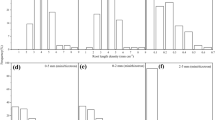Abstract
Applications and limitations of the minirhizotron technique (non-destructive) in relation to two frequently used destructive methods (soil coreing and ingrowth cores) is discussed. Sequential coreing provides data on standing crop but it is difficult to obtain data on root biomass production. Ingrowth cores can provide a quick estimate of relative fine-root growth when root growth is rapid. One limitation of the ingrowth core is that no information on the time of ingrowth and mortality is obtained.
The minirhizotron method, in contrast to the destructive methods permits simultaneous calculation of fine-root length production and mortality and turnover. The same fine-root segment in the same soil space can be monitored for its life time, and stored in a database for processing. The methodological difficulties of separating excavated fine roots into living and dead vitality classes are avoided, since it is possible to judge directly the successive ageing of individual roots from the images. It is concluded that the minirhizotron technique is capable of quantifying root dynamics (root-length production, mortality and longevity) and fine-root decomposition. Additionally, by combining soil core data (biomass, root length and nutrient content) and minirhizotron data (length production and mortality), biomass production and nutrient input into the soil via root mortality and decomposition can be estimated.
Similar content being viewed by others
References
Arthur M A and Fahy T J 1992 Biomass and nutrients in an Engelmann spruce subalpine fir forest in north central Colarado: pools, annual production and internal cycling. Can. J. For. Res. 22, 315–325.
Bates G H 1937 A device for the observation of root growth in the soil. Nature 139, 966–967.
Böhm W 1974 Minirhizotrons for root observations under field conditions Z. Acker Pflanzenb. 140, 282–287.
Cox T L, Hams W F, Asmus B S and Edwards N T 1978 The role of roots in biogeochemical cycles in an eastern deciduous forest. Pedobiologia 18, 264–271.
Fahey T J and Arthur M A 1994 Further studies of root decomposition following harvest of a northern hardwoods forest. For. Sci. 40, 618–629.
Fahey T J 1992 Mycorrhizae and forest ecosystems. Mycorrhiza 1, 83–89.
Flower-Ellis J G K and Persson H 1980 Investigation of structural properties and dynamics of Scots pine stands. Ecol. Bull. 32, 125–138.
Heeramam D A, Crown P H and Juma N G 1993 A color composite technique for detecting root dynamics of barley (Hordeum vulgare L.) from minirhizotron images. Plant and Soil 157, 275–287.
Hendrick R L and Pregitzer K S 1992 The demography of fine roots in a northern hardwood forests. Ecology 73, 1094–1104.
Hendrick R L and Pregitzer K S 1996 Applications of minirhizotrons to understand root function in forests and other natural ecosystems. Plant and Soil 185, 291–302.
Joslin J D and Henderson G S 1982 A test of the budget method: a refined approach to the measurement of the root turnover. Fourth Central Hardwood Forest Conference, 8–10 Nov. 1982, Lexington, Ky. Ed. R N Muller. pp 220–228. University of Kentucky, Lexington, USA.
Joslin J D and Henderson G S 1987 Organic matter and nutrients associated with fine root turnover in a white oak stand. For. Sci. 33, 330–346.
Kurz W A and Kimmins J P 1987 Analysis of error in methods used to determine fine root production in forest ecosystems: a simulation approach. Can. J. For. Res. 17, 909–912.
Majdi H, Smucker A J M and Persson H 1992 A comparison between minirhizotron and monolith sampling methods for measuring root growth of maize (Zea mays L.). Plant and Soil 147, 127–134.
Majdi H and Kangas P 1997 Demography of fine roots in response to nutrient applications in a Norway spruce stand in SW Sweden. Ecoscience (In press).
Majdi H and Nylund J-E 1996 Does liquid fertilization affect fine root dynamics and lifespan of mycorrhizal short roots? Plant and Soil 185, 303–307.
Marshall J D and Waring R H 1985 Predicting the root production and turnover by monitoring root starch and soil temperature. Can. J. For. Res. 15, 791–800.
Persson H 1978 Root dynamics in a young Scots pine stand in Central Sweden. Oikos 30, 508–519.
Persson H and Ahlström K 1991 The effects of forest liming and fertilization on fine root growth. Water Air Soil Pollut. 54, 365–375.
Samson B K and Sinclair T R 1994 Soil core and minirhizotron comparison for the determination of root length density. Plant and Soil 161, 225–232.
Santantonio D and Grace J C 1987 Estimating fine root production and turnover from biomass and decomposition data: a compartment flow model. Can. J. For. Res. 17, 900–908.
Singh J S Lauenroth W K, Hunt H W and Swift D M 1984. Bias and random errors in estimators of net root production: a simulation approach. Ecology 65, 1760–1764.
Smit A L and Zuin A 1996 Root growth dynamics of Brussels sprouts (Brassica olearacea var.gemmifera) and leeks (Allium porrum L.) as reflected by root length, root colour and UV fluorescence. Plant and Soil 185, 269–278.
Smucker A J M 1990 Quantification of root dynamics in agroecological systems. Remote Sens. Rev. 5, 237–248.In Minirhizotron observation tubes: Methods and applications for measuring rhizosphere dynamics. American Socieity of Agronomy Special Publication Number 50. Ed. H M Taylor. pp 67–80. ASA, Madison, WI, USA.
Taylor, H M, Huck M G Klepper B and Lund Z F 1970 Measurement of soil-grown roots in a rhizotron. Agron. J. 62, 807–809.
Vogt K and Persson H 1991 Measuring growth and development of roots.In Techniques and approaches in forest tree ecophysiology. Eds. J P Lassoie and T Hincley. pp 477–501. CRS Press, Inc., Florida, USA.
Author information
Authors and Affiliations
Rights and permissions
About this article
Cite this article
Majdi, H. Root sampling methods - applications and limitations of the minirhizotron technique. Plant Soil 185, 255–258 (1996). https://doi.org/10.1007/BF02257530
Issue Date:
DOI: https://doi.org/10.1007/BF02257530




